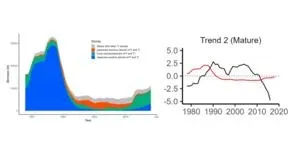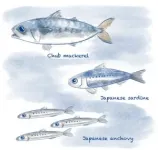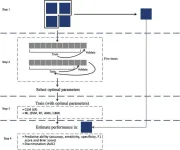(Press-News.org) Scientists have produced the first detailed estimates of how much sediment is transported onto the shores of coral reef islands, and how that might enable them to withstand the future threats posed by climate change.
Coral reef islands are low-lying accumulations of sand and gravel-sized sediment deposited on coral reef surfaces.
The sediments are derived from the broken down remains of corals and other organisms that grow on the surrounding reef. Therefore, the rate of supply of sediment from reefs is a critical control on island formation and future change.
The international team of researchers used data available for 28 reef islands in the Indian and Pacific Oceans, widely acknowledged to be among the world’s most vulnerable environments to rising seas.
By identifying the amount of sediment present within reef islands, and comparing this against the known age of the islands, they were able to determine the average amount of sediment delivered to the islands from surrounding coral reefs over their histories.
They discovered that on average, for every metre of shoreline, around 0.1m3 (equivalent to around 100kg) of sediment is delivered to the islands per year.
It means that for an island with a perimeter of around 2000m, just over 300 dumpy bags of reef-derived sediment are added to the island each year.
They also estimated that only a quarter of the sediment generated on reef surfaces actually reaches the island shoreline and is used for island-building, with the remainder staying within its reefs, or being transported into the ocean or lagoon.
Writing in Geophysical Research Letters, the study’s authors say their findings could go some way to explaining a global observation that most of these islands have grown over the past few decades.
This is in spite of the perception that rising sea levels might erode their shorelines, and disregards artificial island expansion created by local populations.
The research was carried out by experts from the University of Plymouth and National University of Singapore, who have collaborated for many years to examine the threats posed to coastal communities by climate change.
They have previously published research suggesting that so-called island ‘drowning’, whereby remote islands will be flooded as sea levels rise, is not inevitable.
Professor Gerd Masselink, Professor of Coastal Geomorphology at the University of Plymouth, led the study. He said: “These results will help us to predict more accurately how coral reef islands will adjust to sea-level rise. The conventional thinking is that these islands will drown over the next century as the effects of climate change are felt more strongly, but an alternative view is that enhanced flooding due to sea-level rise can help raise the island elevation. The ability of reef islands to naturally adapt to sea-level rise by raising their elevation critically depends on how much sediment they receive each year from the living coral reef system.”
Study co-author Professor Paul Kench, Professor of Tropical Coastal Change from the Department of Geography at the National University of Singapore, has investigated reef island dynamics and evolution for over three decades. He added: “Sediment generation and supply to islands is one of the critical controls on how islands have formed in the past, but also how they will continue to change with rising sea levels. Rates of sediment supply to islands are poorly understood. This research provides an important development in establishing long-term rates of sediment delivery to islands that will support their ongoing adjustment to changing environmental conditions.”
The new study is the first to be produced through the ARISE programme, a £2.8 million initiative being funded UK Research and Innovation’s Horizon Europe Guarantee programme.
The five-year project will include a series of extensive field tests – using state-of-the art coastal process research instrumentation and autonomous survey equipment – in both the Maldives and the Pacific between now and 2027.
There will also be laboratory experiments in the largest wave flume in the world – the Delta Flume at Deltares in the Netherlands – and combined, these tests will enable researchers to explore the impact of overwashing on the islands’ beaches and any natural processes that are adding to their resilience.
The researchers also aim to work with communities and government bodies in the atoll island nations, enabling them to implement adaptation strategies that maximise opportunities for continued habitation.
END
Scientists provide first detailed estimates of how much sediment is supplied to coral islands from the reef system
2024-02-28
ELSE PRESS RELEASES FROM THIS DATE:
Study details five cutting-edge advances in biomedical engineering and their applications in medicine
2024-02-28
Bridging precision engineering and precision medicine to create personalized physiology avatars. Pursuing on-demand tissue and organ engineering for human health. Revolutionizing neuroscience by using AI to engineer advanced brain interface systems. Engineering the immune system for health and wellness. Designing and engineering genomes for organism repurposing and genomic perturbations.
These are the five research areas where the field of biomedical engineering has the potential to achieve tremendous impact on the field of medicine, according to “Grand Challenges at the Interface of Engineering and Medicine,” a study published by a 50-person task force published ...
Traditional regression approach outperformed machine learning algorithms in predicting optimal surgical method in patients with submucosal tumors.
2024-02-28
Submucosal tumors (SMTs) are usually found in the stomach and esophagus during an upper endoscopy. Submucosal tunneling endoscopic resection (STER) and non-tunneling endoscopic resection (NTER) are the two most commonly used techniques in the treatment of gastric and esophageal SMTs. As novel technologies continue to shape the medical landscape, machine learning (ML) algorithms find increased application, demonstrating enhanced performance in various fields. Although some studies have evaluated the incremental value of flexible ML methods, comparisons with traditional logistic regression (LR) models are lacking.
To this end, a recent study by a team of researchers from China published in the ...
A survey on federated learning: A perspective from multi-party computation
2024-02-28
Federated learning (FL) has emerged as a popular machine learning paradigm which allows multiple data owners to train models collaboratively with out sharing their raw datasets. It holds potential for a wide spectrum of nalytics applications on sensitive data. For example, federated learning has been applied on medical big data analysis such as disease prediction and diagnosis without revealing the patients’ private medical information to thirdparty services. It has also been exploited by banks and insurance ...
New pediatric cancer marker, new hope for a treatment target
2024-02-28
Researchers have newly identified a universal, essential biomarker for the childhood cancer neuroblastoma – and a potential new target for treatment.
Neuroblastoma accounts for 15% of all pediatric cancer deaths and is the most common source of childhood tumors outside of brain cancer. The disease develops in early nerve tissue, usually in and around the adrenal glands, and typically affects children under age five. High-risk cases have a five-year survival rate of just 50%.
Led by UC San Francisco, researchers suspected the oncoprotein AF1q, which is known to play a role in leukemia and solid tumor progression, might be important in tumors of neural origin ...
Could we assess autism in children with a simple eye reflex test?
2024-02-28
Scientists at UC San Francisco may have discovered a new way to test for autism by measuring how children’s eyes move when they turn their heads.
They found that kids who carry a variant of a gene that is associated with severe autism are hypersensitive to this motion.
The gene, SCN2A, makes an ion channel that is found throughout the brain, including the region that coordinates movement, called the cerebellum. Ion channels allow electrical charges in and out of cells and are fundamental to how they function. Several variants ...
Researchers closer to understanding hydrogen's great challenge
2024-02-28
Why hydrogen causes steels to become brittle and crack is the great conundrum of engineers and researchers looking to develop large-scale transport and storage solutions for the hydrogen age – an era which Australia hopes to lead by 2030.
They may now be one step closer to understanding how hydrogen affects steels, thanks to new University of Sydney research. The researchers found adding the chemical element molybdenum to steel reinforced with metal carbides markedly enhances its ability to ...
Concerted efforts urgently needed to meet 2030 Global Alcohol Action Plan targets
2024-02-28
Concerted international efforts are urgently needed to meet the targets set out in the 2030 Global Alcohol Action Plan (GAAP) and avert “dire consequences” for low and middle income countries, where alcohol markets are expanding, warn health scientists in the open access journal BMJ Global Health.
A lack of progress on alcohol and health in the wake of the 2010 Global Strategy for Reducing the Harmful Use of Alcohol prompted the 75th World Health Assembly to initiate the Global Alcohol Action Plan 2022-30 and declare alcohol a public health priority, ...
Sinusitis linked to 40% heightened risk of rheumatic disease
2024-02-28
The common inflammatory condition sinusitis is linked to a 40% heightened risk of a subsequent diagnosis of rheumatic disease, particularly in the 5 to 10 years preceding the start of symptoms, finds research published in the open access journal RMD Open.
The risks seem to be greatest for a blood clotting disorder (antiphospholipid syndrome) and a condition that affects the body’s production of fluids, such as spit and tears, known as Sjögren’s syndrome, the findings indicate.
Sinusitis refers to inflammation of the lining of ...
Poorly controlled asthma emits same quantity of greenhouse gas as 124,000 homes each year in the UK
2024-02-28
Patients whose asthma is poorly controlled have eight times excess greenhouse gas emissions compared with those whose condition is well controlled—equivalent to that produced by 124,000 homes each year in the UK—indicates the first study of its kind, published online in the journal Thorax.
Improving the care of asthma patients could achieve substantial carbon emissions savings, and help the NHS meet its net zero target, say the researchers.
Healthcare is a major contributor to greenhouse gas emissions and in 2020 the NHS set an ambitious target of reducing its carbon footprint by 80% over the next 15 years, with the aim of reaching net zero by 2045, ...
Whole genome sequencing reveals new genetic marker for cardiomyopathy
2024-02-28
In the first study to use whole genome sequencing to examine tandem repeat expansions in heart conditions, scientists at The Hospital for Sick Children (SickKids) have laid the groundwork for early detection of and future precision therapies for cardiomyopathy.
Cardiomyopathy is an inherited heart condition that impacts up to one in 500 individuals. The condition affects the structure and function of the heart and can ultimately lead to heart failure.
The SickKids-led study, published in eBioMedicine, part of The Lancet Discovery Science, indicates that tandem repeats – a form of genetic variation – are more often expanded ...




